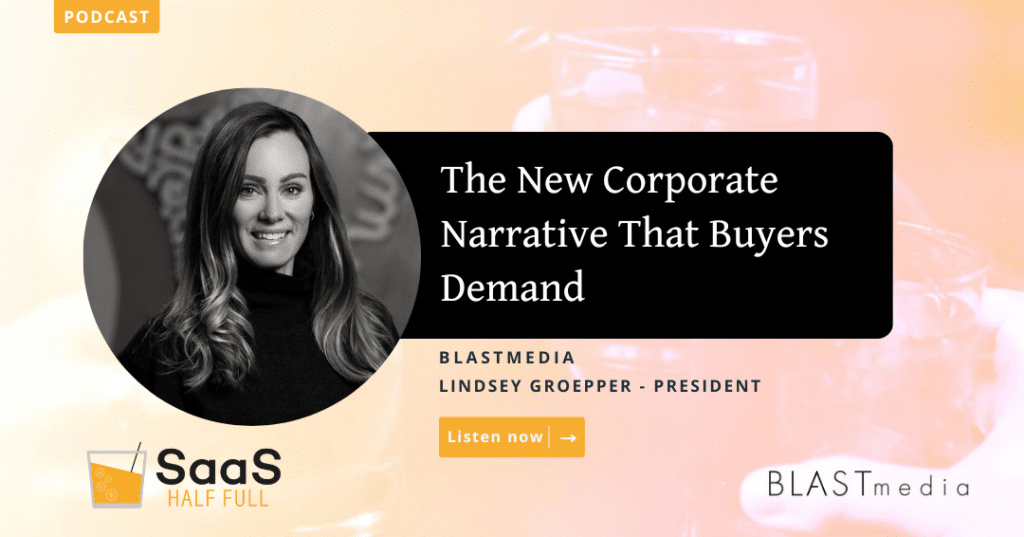Millennials, who value purpose and meaning when choosing SaaS vendors, comprise most of today’s B2B decision-makers. So why are you still pushing narratives centered on products and features?
Today’s modern corporate narrative has evolved from CEO-driven corporate talk tracks to more personal, human-centered narratives to form connections with a new generation of buyers. This week, SaaS Half Full’s host, Lindsey Groepper, flies solo as she unpacks the current demands of the modern corporate narrative and how to evolve yours to build trust and establish connections.
The importance of brand
“I still have conversations with SaaS founders and CEOs who question the idea and the ROI of brand,” said Lindsey. “Brand could not matter more than it does right now.”
Businesses win categories by humanizing their brand and showing up in a way that resonates with today’s new buyers. Millennials make over 75% of all B2B buying decisions — decisions often determined by the answers to these make-or-break questions:
- Do I trust this brand?
- Do I feel a connection with this brand?
- Do I see a purpose in this purchase?
While companies still comment on earnings, momentum and new products and features, that commentary just doesn’t cut it as the only strategy.
So, what does cut it? How do you humanize your brand? Lindsey suggested the following approaches.
Leverage subject matter experts.
Humanize your brand by lifting the CEO and corporate spokesperson and the more non-traditional subject matter experts, including your Chief Human Resource Officer (CHRO), Diversity, Equity, Inclusion and Belonging (DEIB) leader or your sustainability and corporate responsibility program leader.
“The storylines and the programs running underneath those departments are storylines that you need to uncover and promote externally,” said Lindsey. “Maybe you’re literally running the best, kick-ass, most invested mental health support program in the industry — you need to tell the world about that and not keep it a secret.”
Share these stories externally. Pitch tier-one media. They want to hear from leaders who’ve implemented interesting and successful programs.
Embrace Vulnerability
Founders and CEOs need to embrace discomfort. This journey of self-discovery helps them understand who they are as leaders and what that means for their teams. After all, people seek an authentic leader, and a culture add to the partners, talent and customers they bring on.
Lindsey urges founders and CEOs to embark on a journey of self-reflection, asking:
- How can I show up as a real human outside of just wearing my corporate hat?
- What drives my leadership approach?
- How do I feel about certain programs, initiatives, or regulations that have been passed?
By embracing their humanity and articulating their opinions, leaders foster deeper connections with their teams and cultivate a more genuine brand identity.
“Your goal here isn’t to appeal to everyone,” said Lindsey. “Your goal here is to be completely authentic and transparent so that, again, you’re a culture add to those around you. And once you put your opinions and true self out there, it’s up to those people in your ecosystem to join it or not join it. And that’s okay.”
Prioritize transparent and consistent communication.
Today’s buyers demand openness and expect brands to respond quickly in all situations, good or bad. “They need you to be agile in that narrative,” said Lindsey. “They want you to be transparent.”
In addition, customers want to know how companies handle their data. Lindsey advised that brands embrace a “data privacy and security first” approach in their messaging.
Modern brand storytelling also needs messaging alignment across channels and spokespeople. Lindsey cautioned that brands can’t “show up on one social issue and then disappear for the rest of the time until the next big social issue.” Instead, they must weave their narrative into the fabric of their communication, reinforcing it regularly. While narratives may evolve, consistency builds credibility.
Stay authentic
Amid pressure to appeal to everyone, brands must remain loyal to their core identity. “When you have the vocal minority piping in, you know you’re being authentic,” said Lindsey. You know that you have an opinion or point of view that is authentic to you, that doesn’t necessarily match everybody else, and that is okay.”
However, as you develop your narratives for the year or look at your positioning, you must go beyond discussing products, features and benefits.
“Scaling your revenue will certainly help you win quarters, but building a strong brand that people trust and connect with will ultimately win categories,” said Lindsey.
Listen to episode 366 of SaaS Half Full for more of Lindsey’s actionable insights on humanizing your brand.

